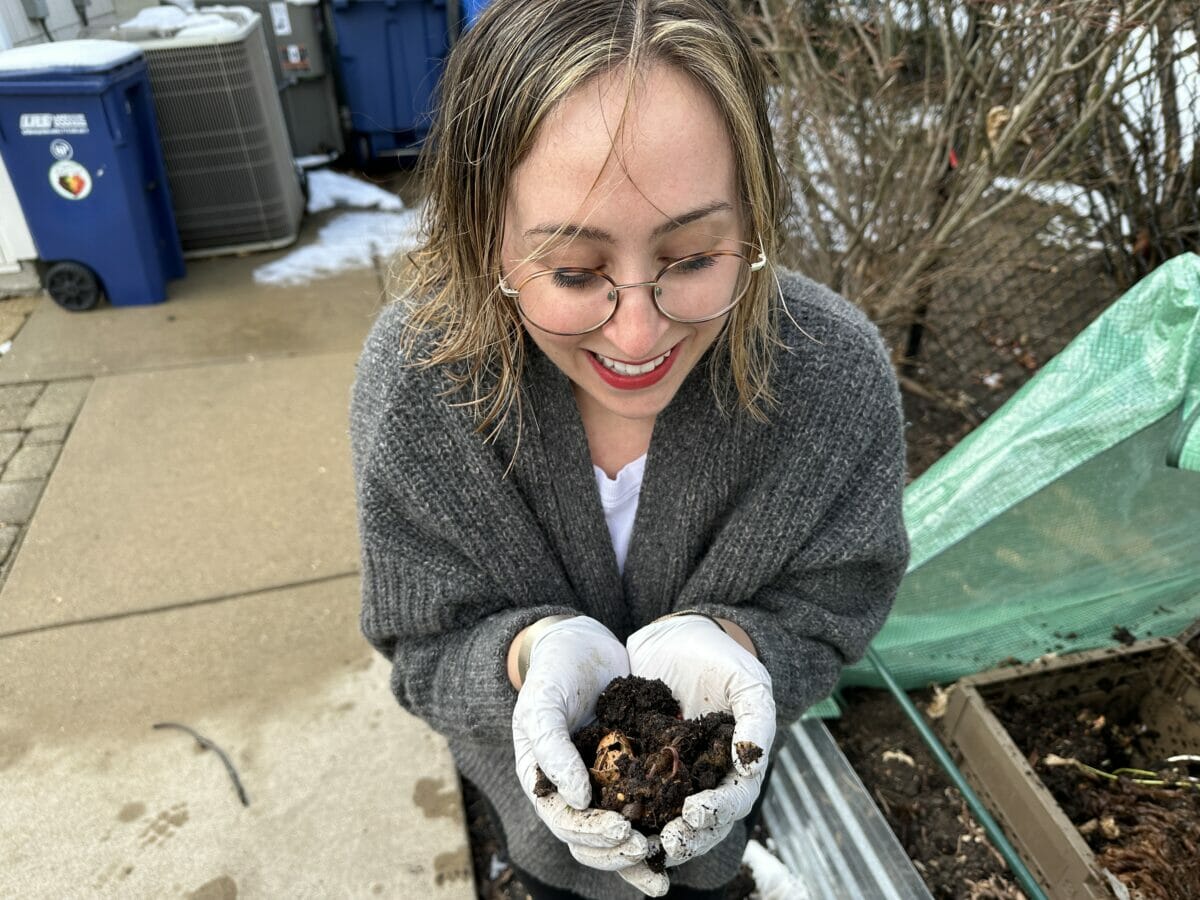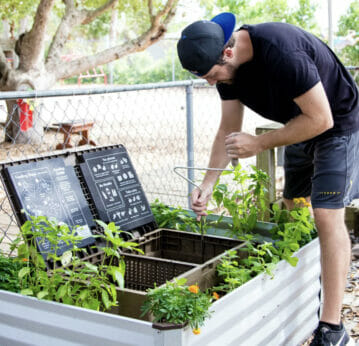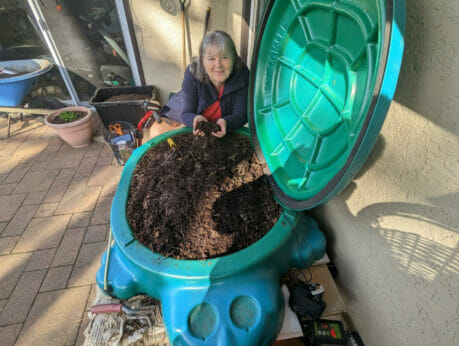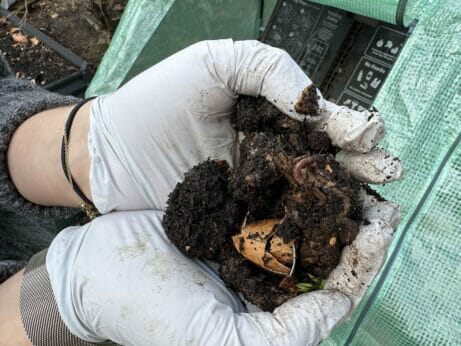I discovered that worms may be my best chance at fighting climate change.

Just a few years ago, I barely recycled. Living in a Hobbit-sized apartment in Brooklyn, I didn’t want to use up precious space with a recycling bin, especially because the recycling situation in my building was non-existent anyway.
So when my husband and I absconded to the suburbs of Chicago during the pandemic, I was excited to finally have space to do things right and make up for my non-recycling sins by not just recycling but composting, too. I knew that compost is good for gardening—and had grand plans for my new backyard. Why not keep my food waste from landfills and improve my garden all at the same time?
What I didn’t know was just how impactful this decision could be for the environment. “Most people don’t realize that food waste in landfills is a huge contributor to climate change,” says Rhonda Sherman, Extension Solid Waste specialist at NC State University, who literally wrote the book on vermicomposting. (In fact, 8%-10% of global greenhouse gas emissions are associated with food waste.) “When food waste is in an airless environment, it breaks down very slowly and releases methane. It actually makes landfills themselves—which are the number three human activity that is causing climate change—more toxic.”
More than 50% of municipal garbage put onto your curb—as part of the 167 million tons of trash sent to landfills each year—is actually compostable, according to the EPA. Think of what we could accomplish by actually composting some of that trash. And it’s not that difficult to get started.
RELATED: The Visionaries Running a Worm Farm In Prison
If you’ve never composted before or you live in a town that doesn’t collect your food scraps, there are two main ways to do it at home. The most common is called thermophilic composting, a process by which microbes and enzymes break down food scraps into organic matter. The process produces heat, which is why you’ll often see outdoor compost piles steaming. Because of the heat production and anaerobic microbes, you can’t really have a thermophilic compost pile indoors. Then there’s vermicomposting, Rhonda Sherman’s specialty, which uses worms to digest food scraps and produce castings (essentially worm manure that makes for a nitrogen-rich soil amendment).
While both methods do create compost and keep food from landfills, the actual product is very different. A cubic yard of regular compost sells for up to $35. Vermicompost? $200 to $1,200 per cubic yard. That’s because the plant growth hormones and humic and fulvic acids in vermicompost create more growth, a higher yield and better root development. They can also help suppress diseases and pests. Plus, the microorganisms keep the smell at bay, so you can even vermicompost indoors.
What ultimately drew me to vermicomposting was discovering the Subpod, a vermicompost bin that is set inside a garden bed. Since it’s mostly underground and surrounded by soil, the worms are protected from harsh winters and direct sunlight. Plus, it has filters, which allow air to circulate through and help the aerobic (non-stinky) microbes work faster. With holes along the sides for worms to move from the bin to the bed and back again, the Subpod also promises to create not just healthy vermicompost but a healthier environment for plants and flowers inside the bed itself. As a food writer, the idea of a lush garden brimming with produce was enough motivation to pay the some $200 for the setup.

A promotional photo of the Subpod. (Image via Subpod)
Getting everything together was simple. But I was not prepared for the “vermi” part of this compost. When the box of red wiggler worms arrived at my doorstep, I picked it up like it was a grenade without the pin and dumped the squirming worms into the bottom of the bin. I was full of fear and regret, but was determined to not have wasted the money I had invested in my bid for self-improvement.
Once the worms were settled in with their bedding (damp newspaper strips), I began adding food scraps from our countertop collection bin every week or so. Since worms breathe through their skin, they need an environment that’s about 60%-80% moisture: that’s why if I have a particularly juicy feeding, I add some sort of dried carbon, like bits of cardboard, newspaper, dried leaves or even sawdust. If you have the right balance of carbon (all this dried stuff) and nitrogen (food stuff), the worms will eat and reproduce happily. Aside from feeding, the Subpod team also recommends that you aerate the mixture to make sure the worms are getting enough oxygen.
Despite my initial squirminess with my worms, I quickly got into the flow of feeding, aerating and reaping the benefits—and discovered whole communities of other vermicomposters, too.
There’s Sandra Birrell, a PhD in Cooperative Education, who is also a volunteer accessibility garden mentor on Vancouver Island. She manages the four in-ground worm bins in her garden, two tiered stacking outdoor worm farms, an outdoor worm farm made from a converted children’s sandbox (pictured) and a temporary indoor worm bin all from her mobility scooter—and is expecting to produce about 70 gallons of worm castings this year. “Choosing the right container is important, not only in terms of what’s best for the worms but also the best for me,” she says. “Worm castings are heavy, so I make sure to use lightweight containers. Ones with built-in grips or handles are best so you can move it around with just one arm if you need to.” From there, it’s simple for her to maintain the bins, feed the worms and harvest the castings from a seated position. Her top tip? Blend your food scraps in a food processor, then keep the mixture in plastic bags in the freezer to give your worms a “mixed buffet” whenever it’s time to feed them.

Sandra Birrell’s worm sandbox. (Photo courtesy of Sandra Birrell)
For Myles Stubblefield, a veteran managing PTSD, worm farming is a cathartic experience that helps him manage stress. He’s the founder and self-described “Benevolent King of Worms” of Worm Works in Buffalo, New York, an urban worm farm and composting service that collects food scraps from nearby restaurants, residential spots and Highmark Stadium (home of the Buffalo Bills). With the scraps, he makes healthy vermicompost, then sells it online and runs workshops for locals interested in the process. It’s the silent chores that come along with composting—such as moving and aerating the thousands of pounds of compost and food scraps by hand—that make Myles jump out of bed at 4 a.m. every day without even setting an alarm. It’s a “cleansing meditation,” he says, one that quiets his brain and makes him grateful for each day.
Sandra and Myles aren’t the only ones. Rhonda tells me that tens of thousands of people around the world practice vermicomposting. In fact, people from 124 countries have reached out to her to learn how to get started. She says that you don’t even need an expensive setup like the Subpod. She even has a whole YouTube video on how to set up a simple vermicompost bin. All you need is a bin with a top, which you can buy at any Walmart, Target or hardware store. You can leave it outdoors or keep it inside. All of your steps will be the same: Add your worms and some damp worm bedding, add your food scraps and wait.

The author with a handful of composted food waste. (Photo: Ariel Kanter)
Two years since dropping the Subpod into my garden bed, my worms are going strong. Whenever I open the bin, I am astounded by what these tiny little marvels can accomplish.
I’m going away this weekend and need to feed them before I leave. I’ve got two buckets on my counter full of carrot fronds, banana peels, coffee grounds, egg shells and squash skins. It’s gotten a little icky and juicy by now, but that’s okay. The worms don’t mind.
The worms, which were once horrifying to me, are sort of like my pets now. Over the past two years, they’ve processed hundreds of buckets of food waste and truly made my garden bountiful. And they continue to create miracles: Last summer, a cantaloupe seed sprouted in the compost, I plucked it out, planted it and grew another cantaloupe. It was delicious.
Thank you for the opportunity to talk about my worms, Ariel! I should mention that my garden has never been healthier and, with each year, it keeps getting better. You inspired me to do a YouTube video on wheelchair worm farming (@NanasWorms). As a lifelong gardener, worm farming gives me the opportunity to contribute to my garden in a way I never imagined and one that gives the most benefit of anything I’ve ever done.
~ Sandra
Very well written and informative. I intend to try composting, see what happens see how far I can get . Rick. l.